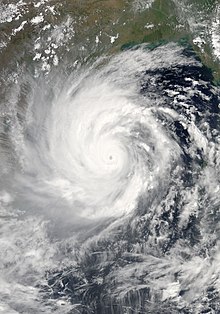
Back अम्फान महाचक्रवात AWA ঘূর্ণিঝড় আম্পান Bengali/Bangla Ciclón Amphan Spanish چرخند آمفان Persian Sykloni Amphan Finnish Cyclone Amphan French अम्फान महाचक्रवात Hindi Siklon Amphan ID Ciclone Amphan Italian 사이클론 엄펀 Korean
 Amphan near peak intensity over the Bay of Bengal on 18 May | |
| Meteorological history | |
|---|---|
| Formed | 16 May 2020 |
| Dissipated | 21 May 2020 |
| Super cyclonic storm | |
| 3-minute sustained (IMD) | |
| Highest winds | 240 km/h (150 mph) |
| Lowest pressure | 920 hPa (mbar); 27.17 inHg |
| Category 5-equivalent tropical cyclone | |
| 1-minute sustained (SSHWS/JTWC) | |
| Highest winds | 270 km/h (165 mph) |
| Lowest pressure | 901 hPa (mbar); 26.61 inHg |
| Overall effects | |
| Fatalities | 128 total |
| Damage | $14 billion (2020 USD) (Costliest on record in the North Indian Ocean) |
| Areas affected | India (West Bengal, Odisha, Andaman Islands), Bangladesh, Sri Lanka, Bhutan, Myanmar, Thailand |
| IBTrACS | |
Part of the 2020 North Indian Ocean cyclone season | |
Super Cyclonic Storm Amphan (/ˈəmpʔən/) was an extremely powerful and catastrophic tropical cyclone that caused widespread damage in Eastern India, specifically in West Bengal and Odisha, and in Bangladesh, in May 2020. It was the strongest tropical cyclone to strike the Ganges Delta. It was a rare cyclone that lashed northern Bangladesh from Rajshahi to Rangpur in the early hours of 21 May with strong winds. It caused severe damage to mango production of Rajshahi and Rangpur. It was also the fourth super cyclone that hit West Bengal and Kolkata since 2015 as well as being one of the strongest storms to impact the area.[1][2][3] Causing over US$13 billion of damage, Amphan is also the costliest cyclone ever recorded in the North Indian Ocean, surpassing the record held by Cyclone Nargis of 2008.[4]
The first tropical cyclone of the 2020 North Indian Ocean cyclone season, Amphan originated from a low-pressure area persisting a couple of hundred miles (300 km) east of Colombo, Sri Lanka, on 13 May 2020. Tracking northeastward, the disturbance organized over exceptionally warm sea surface temperatures; the Joint Typhoon Warning Center (JTWC) upgraded the system to a tropical depression on 15 May while the India Meteorological Department (IMD) followed suit the following day. On 17 May, Amphan underwent rapid intensification and became an extremely severe cyclonic storm within 12 hours.
On 18 May, at approximately 12:00 UTC, Amphan reached its peak intensity with 3-minute sustained wind speeds of 240 km/h (150 mph), 1-minute sustained wind speeds of 270 km/h (170 mph), and a minimum central barometric pressure of 920 mbar (27.17 inHg). The storm began an eyewall replacement cycle shortly after it reached its peak intensity, but the continued effects of dry air and wind shear disrupted this process and caused Amphan to gradually weaken as it paralleled the eastern coastline of India. On 20 May, 12:00 UTC, the cyclone made landfall in West Bengal. At the time, the JTWC estimated Amphan's 1-minute sustained winds to be 175 km/h (110 mph). Amphan rapidly weakened once inland and dissipated shortly thereafter.
Coastal areas in West Bengal comprising West Midnapore, East Midnapore, North 24 Parganas, South 24 Parganas, Kolkata, Hooghly and Howrah were heavily affected by the cyclone. It also caused significant destruction in Bangladesh, bringing rain and strong winds to Rajshahi and Rangpur. It created havoc in the metro city of Kolkata.[5]
The name Amphan was suggested by Thailand which means 'sky' in Thai. It is pronounced as Um-pun.[6]
- ^ 1. Kumar S, Lal P, Kumar A. Influence of Super Cyclone “Amphan” in the Indian Subcontinent amid COVID-19 Pandemic. Remote SeSyst Sci [Internet]. 2021 Jun 12 [cited 2021 Jun 13]; Available from: https://doi.org/10.1007/s41976-021-00048-z
- ^ "Amphan: Cyclone wreaks deadly havoc in India and Bangladesh". BBC News. 20 May 2020. Retrieved 20 May 2020.
- ^ *Nandi, Jayashree; Thakur, Joydeep (18 May 2020). "Super Cyclonic Storm #Amphan is the 1st SUCS in the Bay of Bengal since the 1999 Odisha Super Cyclone". Hindustan Times. Archived from the original on 18 May 2020. Retrieved 19 May 2020.
- Bose, Joydeep (19 May 2020). "Cyclone 'Amphan' LIVE updates: Second super cyclone after 1999, moving with wind speed of 200-250 kmph, says IMD". DNA India. Archived from the original on 23 May 2020. Retrieved 19 May 2020.
- ^ Sud, Vedika; Rajaram, Prema (22 May 2020). "Cyclone Amphan caused an estimated $13.2 billion in damage in India's West Bengal: government source". CNN. Retrieved 22 May 2020.
- ^ "Cyclone devastates Kolkata and leaves scores dead". BBC News. 21 May 2020. Retrieved 23 May 2020.
- ^ "Naming of Tropical Cyclones over the North Indian Ocean" (PDF). New Delhi: Regional Specialized Meteorological Centre. Archived (PDF) from the original on 3 September 2021. Retrieved 6 December 2023.
© MMXXIII Rich X Search. We shall prevail. All rights reserved. Rich X Search